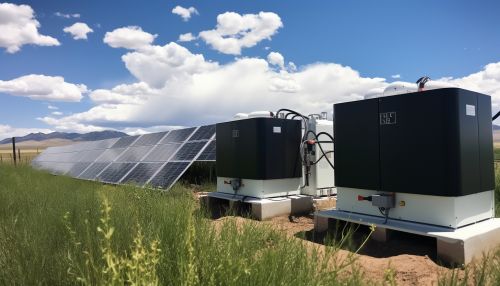Iron-chromium redox flow battery
Introduction
The Iron-chromium redox flow battery (ICRFB) is a type of flow battery that utilizes iron and chromium as the active elements in the electrolyte. The ICRFB is a promising energy storage solution due to its low cost, high energy efficiency, and long cycle life. The battery operates on the principle of redox reactions, where iron and chromium ions are oxidized and reduced to store and release electrical energy.
Structure and Operation
The structure of an ICRFB consists of two tanks, each containing an electrolyte solution, a power cell where the redox reactions occur, and a pump system that circulates the electrolytes. The electrolyte in one tank contains iron ions, while the other contains chromium ions. The power cell is divided into two halves by a proton exchange membrane, which allows protons to pass through but prevents the electrolytes from mixing.
During charging, the pump circulates the electrolytes from the tanks through the power cell. In the power cell, the iron ions are oxidized to form iron(III) ions, and the chromium ions are reduced to form chromium(III) ions. This process stores electrical energy in the form of chemical potential energy. During discharging, the reverse reactions occur, releasing the stored energy as electrical energy.


Advantages and Disadvantages
The ICRFB has several advantages over other types of flow batteries and energy storage systems. The use of iron and chromium, which are abundant and inexpensive, makes the ICRFB a cost-effective solution for large-scale energy storage. The battery also has a high energy efficiency, typically over 80%, and a long cycle life, with some systems capable of over 10,000 cycles.
However, the ICRFB also has some disadvantages. The energy density of the ICRFB is relatively low compared to other types of batteries, which means that the battery requires a large volume of electrolyte for a given amount of energy storage. The battery also requires a complex pump system to circulate the electrolytes, which can increase the cost and complexity of the system.
Applications
The ICRFB is suitable for a variety of applications, including grid energy storage, renewable energy integration, and backup power supply. In grid energy storage, the ICRFB can be used to store excess electricity during periods of low demand and release it during periods of high demand, helping to balance the grid and reduce the need for peaking power plants. In renewable energy integration, the ICRFB can store energy generated by intermittent renewable sources, such as wind and solar, and release it when needed, increasing the reliability and usability of renewable energy. In backup power supply, the ICRFB can provide a reliable and long-lasting power source in case of power outages.
Future Developments
Research and development efforts are ongoing to improve the performance and reduce the cost of the ICRFB. These efforts include the development of new electrolyte formulations, improvements in the design and materials of the power cell, and optimizations of the pump system. With these advancements, the ICRFB has the potential to become a major player in the energy storage market in the future.
